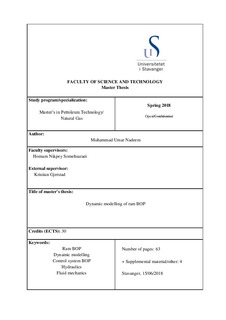| dc.contributor.author | Nadeem, Muhammed Umar | |
| dc.date.accessioned | 2018-10-23T15:09:30Z | |
| dc.date.available | 2018-10-23T15:09:30Z | |
| dc.date.issued | 2018 | |
| dc.identifier.uri | http://hdl.handle.net/11250/2569208 | |
| dc.description | Master's thesis in Petroleum engineering | nb_NO |
| dc.description.abstract | As the closing time of Blowout Preventer rams is safety critical, this thesis proposes a dynamic model to calculate the closing time of a ram Blowout Preventer. The thesis work includes guidelines to recreate such a model that is applicable for most blowout preventer control system designs. The model can also be modified to recreate various scenarios and equivalent models for shear ram, blind and/or pipe rams. The main focus of the study is to generate a concept and establish ordinary differential equations. These differential equations define the changes in pressure and flowrate, as the position and velocity of the ram varies during the ram Blowout Preventer operations. The concept is then modelled to test and investigate the accuracy and reliability of the results.
The model is implemented in Matlab and constitutes of both hydraulic actuators and ram mechanics. The calculations in MATLAB are done using Euler’s integration and second order derivatives. The model assumes a specific pressure at the master regulator valve supplied by the accumulator bank and simulations are performed to test if the pressure support is enough to complete the actuation process. The calculations account for the friction losses through the control system, hydraulic actuators and the interface between shear ram and the annulus. Two different closing operations in a Blowout Preventer are put into focus i.e. when there is a drill pipe present in the well bore (scenario 1) and there is no drill pipe where the ram moves freely (scenario 2).
The dimensions of the equipment used for the present study are taken from various published studies. The model is designed in conjunction with API16D and NORSOK standards. The model in the present study is developed in accordance to the boundary conditions of scenario 1 and the results obtained show a good agreement with the published studies. However, the present model exhibits few discrepancies for scenario 2 when compared with the published results. This also concludes that the model established for a scenario is not applicable for other scenarios. | nb_NO |
| dc.description.sponsorship | MHWirth | nb_NO |
| dc.language.iso | eng | nb_NO |
| dc.relation.ispartofseries | Masteroppgave/UIS-TN-IEP/2018; | |
| dc.subject | petroleum technology | nb_NO |
| dc.subject | petroleumsteknologi | nb_NO |
| dc.subject | dynamic modelling | nb_NO |
| dc.subject | control system BOP | nb_NO |
| dc.subject | hydraulics | nb_NO |
| dc.subject | fluid mechanics | nb_NO |
| dc.subject | hydraulikk | nb_NO |
| dc.title | Dynamic modelling of ram BOP | nb_NO |
| dc.type | Master thesis | nb_NO |
| dc.description.version | submittedVersion | nb_NO |
| dc.subject.nsi | VDP::Teknologi: 500::Berg‑ og petroleumsfag: 510::Petroleumsteknologi: 512 | nb_NO |
